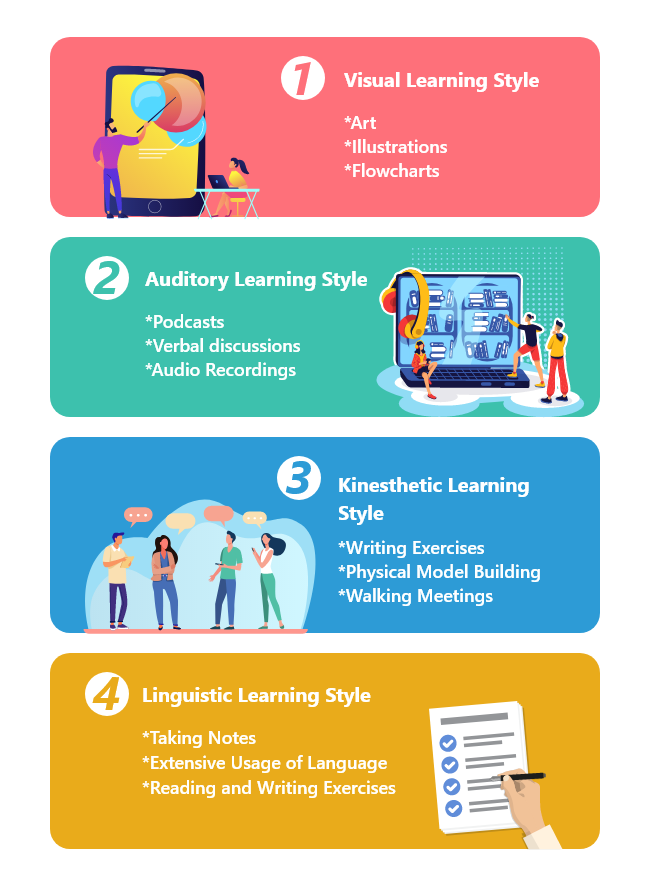What is the best way to study?
The moment you read this question, a spontaneous thought ran across your mind. The attempt was to pick out that one pattern of study that worked for you to score the best grades in your career. And, you have held onto it ever since.
The study pattern we exclusively follow is a very personal aspect of our learning. The practice develops over time and once the success rate is achieved, it becomes our ‘best way to study’.
With all the pride intact, what if I told you there is a possibility to upscale the practice?
Trim out the less required constraints, and strengthen the efficiency of the primary traits? The traits which define your natural learning style?
How? And what exactly is ‘learning style’?
Your best way to study will always be different from mine, or from your friends. As I mentioned earlier, it is a unique, self-developed habit. But the fundamental block in this habit, which is naturally inhibited by all of us is ‘Learning Style’.
Simply put, learning style is the way you learn and research states that each one of us learns differently.
Primarily, there are 4 fundamental ways in which a student learns.
(Note: Order has no relevance to efficiency)
- Visual Learning- Learning by looking at things, observing them (Pictures, art, illustrations etc.)
- Auditory Learning- Learning by hearing things (keen sense of hearing, great verbal ability )
- Kinesthetic Learning- Learning through physical interactions (hand gestures, developed physical abilities)
- Linguistic Learning- Learning though extensive reading and writing exercises (rich vocabulary, great with language)
 Exhibit all 4 of them?
Exhibit all 4 of them?
Generally, an individual exhibits a balance of all 4 learning styles but in one of the styles, he/she thrives.
Let’s find out the best way you should study based on your style of learning.
Best Way To Study According To Your Learning Style
Before we dive in further, let’s have a small exercise.
Select the scenario from below that you absolutely fit in:
First Scenario: Are you really accurate with maps and directions?
Second Scenario: Do you notice detailed sounds in songs that your friends generally miss out on?
Third Scenario: Do you prefer writing down points to understand them better?
Fourth Scenario: The language plays a very important role in your understanding of the concept?
Hint: It might be a close call but there will be a definitive winner!
Selected?
Now, remember your choice as we categorize each scenario into a fundamental learning style with insights on how to study accordingly.
1. Visual Learning
Visual learners are individuals with a keen sense of observation. They learn best with illustrations, diagrams, flowcharts, etc.
For a visual learner, it is crucial to see the data in some form of visual representation.
If your selection was the First Scenario, you are a visual learner.
The study tips you can inculcate to enhance your best way to study would be:
- Creating Visual Notes
The practice to translate a given form of data into a visual representation like pie-chart, flowchart, diagrams, etc.
- Opting for Visual Media
If there’s an option to learn from Powerpoint Presentation, infographics, or videos, opt for them without any second thoughts.
- An Aesthetically Pleasing surrounding
Since so much of your efficiency is dependent upon your visual inspection of data, a neat, in order study space adds up to the value of the final output.
2. Auditory Learning
Auditory learners have a keen sense of hearing. They tend to learn the most when things are verbally directed to/ discussed with them.
The involvement of sound while learning is what works out the charm here.
If you connected with the Second Scenario, the study tips for you to fine-tune your best way to study would be to:
- Discuss the content
When around with friends for group study sessions; questions or ideas, try discussing the subject as much as possible.
- Use of “Text-to-Speech” software
With technical advancement at its peak, there are many open-ended software that translates a given piece of text on a device to speech.
Use them to get the important information narrated to you.
- Read out loud while learning
When studying alone, try reading out the topic. The various nodes of sound trigger a better output of memory and understanding.
- Choose A Calm and Quiet Environment
With a sharp sense of hearing, it is quite easy for you to get distracted by the noises around you.
While studying, make sure you are in a calm, quiet environment.
3. Kinesthetic Learning
For a Kinesthetic Learner, it is crucial to make physical movements while learning.
Because of their advanced coordination and fine motor skills, learning becomes easier for them by being physically active while studying.
The Third Scenario a regular practice for you?
Then, the best way to study for you would be:
- Gesture learning
Try to introduce gestures while trying to understand the information. This saves a muscle memory attached to the learning.
- Modeling of information
Make it a practice to create a model or a poster to explain the information.
- Enabling Periodic Breaks
Have troubles with long hours of constant sitting?
It’s absolutely your way!
Kinesthetic learners need to move around in a while to process information better. A break to move around in a while can work wonders for you!
4. Linguistic Learning
The efficiency of a linguistic learner depends a lot on verbal and auditory exchange of information. They love written and spoken language.
Much like Auditory Learning?
Not exactly.
While an Auditory learner focuses more on sounds, a Linguistic Learner pays more attention to the words said. Owing to their rich vocabulary, they just love writing, hearing, and speaking out words.
If Fourth Scenario is the condition where you thrive, then you are a linguistic Learner.
To revamp your best way to study, you need to:
- Writing and Hearing
Since your strong suit lies in usage of vocabulary, reading and writing exercises have to be a part of your daily routine.
- A New Way Everyday
The habit to use various words to understand one particular information will always work in your favor. It suits your ability to tackle word complexity, hence understanding the concept you are trying to grasp in the process.
- Mnemonics!
Voila! A new word to learn.
The usage of tools to gather large amounts of information is called Mnemonics.
For example,
To remember the sequence of a elements in the Periodic Table:
B C N O F becomes Bears Cannot Name Out Fruits
This is your skill totally and to explore it in your way is creativity.
There it is, the 4 fundamental learning styles!
And depending upon your learning style; you can make your ‘best way to study’ better.
Which scenario did you relate to and which learning style suits you best? Tell us in the comments section below.
Wish to know more and better? Our unique Learning Style Test can help you identify your unique style of learning and may hold the key to the ‘best way to study’.
Read More: The 4 Types of Learning Styles
Ashit Kumar Samal
A wanderer in every sense of the word, Asit’s love for biking is mostly on full throttle. As a writer, he feeds on satire and sarcasm in every possible way he can manage. Asit’s vision is to explore every aspect of Content Creation, from his laptop, on a warm beach, sipping on sweet Coconut water. Well, ideally!



2 Comments
I don’t really recall the last time I read something on finding and approaching the best way to study, as effective as this read. This will definitely help me exploring my ways to learn something. A big thanks to the writer!
Thank you Ananya! We appreciate your feedback. Make sure you stay tuned to our blog page for more content. 🙂